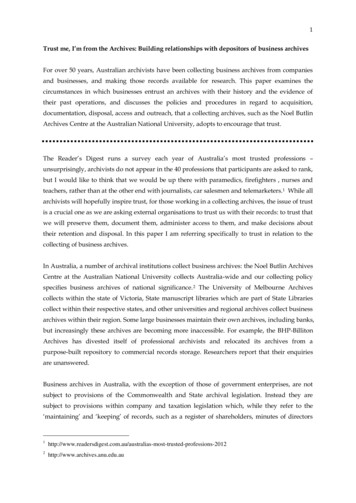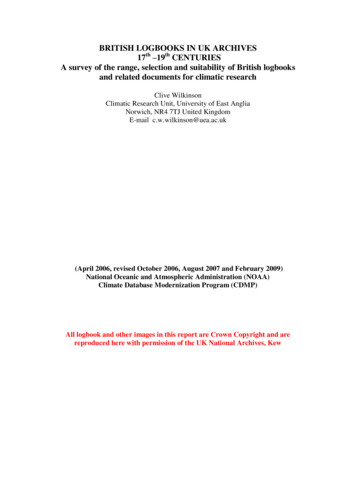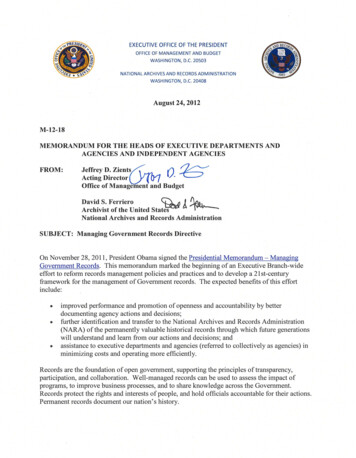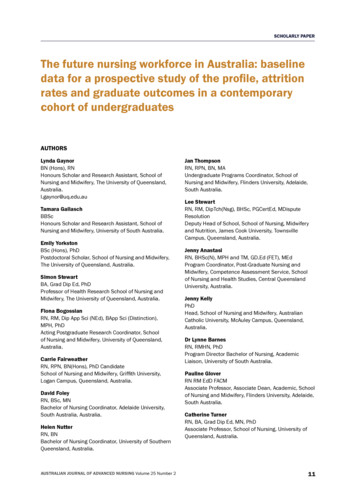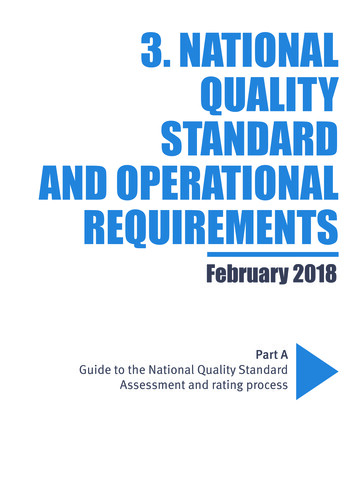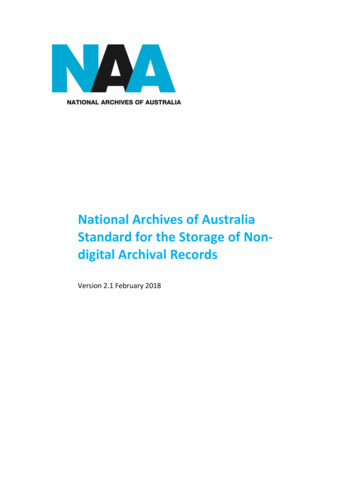
Transcription
National Archives of AustraliaStandard for the Storage of Nondigital Archival RecordsVersion 2.1 February 2018
National Archives of AustraliaStandard for the Storage of Non-digital Archival RecordsDOCUMENT CONTROLTitle of DocumentNational Archives of Australia Standard for the Storageof Non-digital Archival RecordsProposed review dateScheduled periodic review. Next ReviewDecember 20212
National Archives of AustraliaStandard for the Storage of Non-digital Archival Background555Error! Bookmark not defined.2.FRAMEWORK3.RELATED POLICIES AND PROCEDURESERROR! BOOKMARK NOT DEFINED.4.REVIEW AND UPDATEERROR! BOOKMARK NOT DEFINED.5.ROLES AND RESPONSIBILITIESERROR! BOOKMARK NOT DEFINED.6.APPENDIX 1 STORAGE PRINCIPLESERROR! BOOKMARK NOT DEFINED.Principle 1:Principle 2:Principle 3:Principle 4:Principle 5:Principle 6:Principle 7:Principle 8:Principle 9:6LocationFacility design and constructionEnvironmental controlShelving and packagingAccessibilityHandlingPrivacy and SecurityProtection from disasterMonitoring and maintenance678910101111127.APPENDIX 2 RECOMMENDED TEMPERATURE AND HUMIDITY LEVELS FOR STORAGEOF COMMONWEALTH RECORDS OF ENDURING VALUE138.APPENDIX 3MAXIMUM LIMITS TOLERANCE FOR AIR POLLUTANTS FOR ALLPHOTOGRAPHIC RECORDS, ALL AUDIOVISUAL RECORDS AND RECORDS TO BE KEPTLONGER THAN 30 YEARS (FROM ISO 11799)159.APPENDIX 4 RECOMMENDED SHELVING AND PACKAGING FOR ARCHIVAL RECORDS 1610.APPENDIX 5NAA STANDARD FOR STORAGE CONTAINERS FOR ARCHIVAL MATERIAL18General storage (files, binders, documents, photographs)183
National Archives of AustraliaStandard for the Storage of Non-digital Archival RecordsOutsize or unusually shaped itemsMaps, plans, charts and postersAudiovisual material (motion picture film, magnetic media) and microfilmStill film (photographic negatives, transparencies)11.18181818APPENDIX 6SECURITY REQUIREMENTS FOR PROTECTIVELY MARKED RECORDS.ERROR! BOOKMARK NOT DEFINED.4
National Archives of Australia1.Standard for the Storage of Non-digital Archival RecordsINTRODUCTIONThe National Archives of Australia Standard for the Storage of Non-digital Archival Records ispart of a suite of plans and procedures outlined in the National Disaster Preparedness andRecovery Strategy (NDPRS) to ensure a nationally consistent approach to disaster managementrelating to archival records. In combination, these plans and procedures aim to ensure thatdamage to records in the Archives’ custody is prevented or minimised and staff are aware oftheir roles and responsibilities.1.1PurposeThe purpose of this standard is to mitigate the risk of damage to archival records throughimproper storage. Record storage is a vital component of good records management.Appropriate storage – which takes into account the format and retention period of records helps ensure that records survive as long as they are required for business and accountabilitypurposes.1.2ScopeThe standard is designed to: Set out the requirements for the safe storage and preservation of non-digital recordsin the Archives’ custody. Ensure all non-digital records are protected, secure and accessible for as long as theyare required to meet business and accountability needs and community expectations Ensure all non-digital records are stored in the most cost-effective manner possibleThe standard is a code of best practice, and provides a tool to support and improve the storageand management of Commonwealth records.The standard applies to the following forms of physical records: Paper files and documents Volumes and registers Maps, plans and drawings Photographic material, including black and white photographs and negatives, colourphotographs and negatives, slides, transparencies, cine films, x-rays and microforms Magnetic media, including computer tapes and disks, videotapes, audiotapes Optical media, including laser discs and compact discs.The standard excludes electronic records held on servers or in a data centre.This Standard is reviewed and updated every three years.5
National Archives of AustraliaStandard for the Storage of Non-digital Archival Records2. Storage PrinciplesThe standard outlines nine principles for the storage of non-digital records as listed in the tablebelow.123456789LocationFacility designandconstructionEnvironmentalcontrolShelving andpackagingAccessibilityHandlingPrivacy andsecurityProtectionfrom disasterMonitoringandmaintenanceStorage facilities are conveniently located and not near known hazardsThe design and construction of storage facilities protect and preservethe records.Records are stored in environmental conditions appropriate to theirformat and retention periodThe shelving and packaging of records provide protection from damageand slow deteriorationRecords can be easily identified, located and retrievedRecords are retrieved, handled and used in a manner that preventsdamage and slows deteriorationStorage conditions ensure the privacy and security of the recordsDisaster management programs are established and maintained tominimise risksThe storage facilities are monitored, managed and maintained to ensurethe ongoing safety of stored records.Principle 1: LocationStorage facilities are conveniently located and not near known hazards.When selecting a site, careful attention should be paid to orientation, landscaping, and thesite’s microclimate.RequirementThe site location isconvenient to userneedsThe site is locatedaway from natural andman-made hazardsExplanationRecords storage facilities should not be in remote locations, which mayhinder monitoring, retrieval and access in the case of an emergency.Ideally, facilities should be located adjacent to compatible businesses, insuch locations as a light industrial area, a technology park or a warehouseestate.The site should not be near:- flood plains, creeks, rivers or stormwater drains that are prone to flooding- bushfire-prone areas- land liable to subsidence- heavy industry such as oil refineries, chemical plants, paint or rubberfactories, which may emit atmospheric pollutants or liquid contaminants, orbring risk of explosion- fuel depots- airports- industrial installationsIf any of these risks are present, they should be assessed. If mitigating6
National Archives of AustraliaThe site has gooddrainageStandard for the Storage of Non-digital Archival Recordsmeasures can reduce the risk, they should be put in place.A location with good drainage reduces the potential for damage caused byheavy rain or runoff.Principle 2: Facility design and constructionThe design and construction of storage facilities protect and preserve the recordsThe design and construction fabric of a storage building provides the main protection for therecords stored within. The building foundations, exterior and load bearing walls, floors,columns, windows and roof decking should all be designed with a high level of durability andlongevity.RequirementThe building isconstructed ofappropriate materials,and is well-insulatedThe building’s roof ispitched sufficiently toallow rainwater runoffThe building’sguttering and downpipes are external,high capacity, andwell-maintainedThe storage facilitiesare entirelyweatherproof andsealedStorage areas arededicated to record,or record and librarystorageStorage areas areappropriate for theprotective marking ofthe materialStorage areas areisolated from internalhazardsThe building and itsservices comply withAustralian buildingcodes and standardsthat applied at thetime of constructionExplanationThe building should be designed to provide an accurate and stable internalenvironment, with minimum dependence on mechanical systems. This canbe achieved in part by constructing the external walls, roof and floor of thebuilding from materials with a high thermal capacity (brick, stone, reinforcedconcrete), that insulate the interior from external climatic changes.Flat or gently-pitched roofs may cause pooling. A sufficient roof pitchensures rapid rainwater run-off. Recommended roof falls:Metal: 2 Corrugated iron: 5 Tile/other: 18 A well-maintained drainage system prevents water overflow or blockages.Appropriate sealing in storage areas will protect records from dust,moisture, and pest penetration and also help to stabilise externalfluctuations in temperature and humidity.Records that are not in active use should be stored in a dedicated storagearea which is used only for records or compatible materials, such as librarymaterials. Physical separation enables better access control and helps tomaintain environmental conditions. Other parts of a storage facility may beused to store different types of goods, providing the records are not put atrisk.Storage areas constructed and monitored in accordance with the AustralianGovernment Protective Security Policy Framework and its Physical SecurityManagement Guidelines.Internal hazards may include kitchens, washrooms, electrical plants,overheard pipes, and exposed plumbing, as well as potentially combustiblematerials such as chemicals. Such hazards in storage areas place records atrisk.A building that does not comply with the appropriate building code may notbe safe for records storage. Even if a building does comply with the code itmay still be inappropriate for storing records – for instance, if the floorloading is not sufficient to carry the weight of stored records.7
National Archives of AustraliaStorage areas havesufficient floor loadingcapacity (FLC)Storage areas areseparate from theloading dockStandard for the Storage of Non-digital Archival RecordsFloors should be able to withstand the heavy mass placed upon them byarchival materials and shelving. FLC (generally measured per square foot)can be calculated based on projected mass and quantity of records to bestored. Advice from a structural engineer or other qualified professionalshould be sought.Loading docks should never open directly into a storage area. This couldexpose records to harmful pollutants from car engines, as well as disrupt thestability of environmental conditions.Principle 3: Environmental controlRecords are stored in environmental conditions appropriate to their format and retentionperiodRecords formats are varied, and include paper (files, volumes, maps and drawings),photographic materials (black and white photographs, negatives, slides, transparencies),magnetic media (computer tapes and disks, video tapes, audiotapes), optical media (laserdiscs, compact discs) and mixed media (objects, models).Some record formats are more vulnerable than others and require different environmentalconditions and specialised storage. Of particular concern are audio-visual records andphotographic negatives and transparencies, many of which are prone to ‘vinegar syndrome’, atype of irreversible deterioration.RequirementRegular monitoring isundertakenExplanationRegular monitoring should be carried out in storage facilities to ensure thattemperature and humidity are being maintained at appropriate levels. The risksto records caused by variations in outside temperature and humidity rangesshould be evaluated using a risk management approach.Refer: NDPRS SECTION 1.4 Environmental Monitoring and Control Plan forNon-digital Archival RecordsRecords are storedaccording to theenvironmentalconditions outlined inAppendix 2 –Records are storedaway from directsunlight or otherultraviolet lightsourcesAny lighting used instorage areas shouldhave zero or very lowUV output.Magnetic media arenot stored near toProper control of temperature and humidity is critical for long-termpreservation. High temperature and humidity levels greatly acceleratedeterioration, while high humidity can cause mould to grow, and low humiditycan cause paper to become brittle. Fluctuations in temperature and humiditycan also damage records, causing stress and moisture is frequently absorbedand released.Refer: Appendix 2 Recommended temperature and humidity levels forstorage of Commonwealth records of enduring valueExposure to light damages documents. Records should be housed in protectivecontainers, and direct sunlight should not be allowed to fall on unprotectedrecords.Refer: Appendix 5 NAA Standard for Storage Containers for Archival MaterialThis can be achieved by using special low UV light globes or tubes, or throughfiltration. The impact of UV exposure can also be minimised, and energysavings made, by introducing timer controlled switches for all lighting.Magnetic fields (including magnetised shelving, high voltage power lines,machines with electric motors, lightening arresters and magnetic flashlights)8
National Archives of Australiamagnetic fieldsStorage areas arecleanStorage areas shouldhave continuousfreely circulating air(through use of fans,mechanicalventilation, etc)External air intake isto be filtered toremove dust, pollen,and other pollutantsStandard for the Storage of Non-digital Archival Recordscan permanently distort the data contained in record formats such ascomputer disks and tapes. These formats may require dedicated storage areasand special packaging to protect them from such risk.Staff should follow the procedures as outlined under the site specific Food andDrink PolicyRefer: NDPRS section 1.3 Food and Drink PolicyAir circulation prevents areas of stagnant air and assists with maintainingconstant temperature and humidity conditions. If free circulation of air doesnot occur naturally, a ventilation system should be provided.Air quality is a significant factor in the permanence of stored records. Variousatmospheric pollutants as well as dust and mould spores can endanger orhasten deterioration of records. Pollutant levels should be monitored, and anyair handling system for storage areas should be properly maintained.Refer: Appendix 3 Maximum limits tolerance for air pollutants for allphotographic records, all audiovisual records and records to be kept longerthan 30 years (from ISO 11799)Principle 4: Shelving and packagingThe shelving and packaging of records provide protection from damage and slowdeterioration.When selecting shelving (including shelving, racking and cabinets) and packaging (includingboxes, folders, wallets, bags) the retention period, physical characteristics and expected levelof use of the record should all be considered.RequirementShelving should beclean, in goodcondition, andappropriate to theformat and size ofthe recordsShelving is raised offthe groundContainers areclean, robust, ingood condition andappropriate to theformat andretention period ofthe recordsStorage containersare appropriate forthe protectivemarking of thematerialExplanationSuitable shelving enhances safe access to records, while providing overallsupport to items and protecting them from physical, chemical and mechanicaldamage.Refer: Appendix 4 Recommended Shelving and Packaging for Archival RecordsMinimises the risk of flood damage, dampness or dustAppropriate housing and packaging slows down the rate of temperature andhumidity changes; protects items from light, dust and other pollutants; andminimises damage caused through handling.Refer:Appendix 4 Recommended Shelving and Packaging for Archival RecordsAppendix 5 NAA Standard for Storage Containers for Archival MaterialThe type of security container to store material is determined by the protectivemarking of the material and the physical construction of the storage area asdescribed in the Australian Government Physical Security ManagementGuidelines.9
National Archives of AustraliaMagnetic media arehoused in nonmagnetisableshelvingStandard for the Storage of Non-digital Archival RecordsMagnetic fields (including magnetised shelving, high voltage power lines,machines with electric motors, lightening arresters and magnetic flashlights) candistort the data contained in record formats such as computer disks and tapes.These formats may require dedicated storage areas and special packaging toprotect them from such risk.Principle 5: AccessibilityRecords can easily be identified, located and retrieved.The principle of accessibility should guide decisions made regarding the location of the storagefacility, its design, and physical and intellectual systems used to the control the records.Ensuring that equipment or technology-dependent records remain accessible for as long asthey are required (eg audiovisual material and magnetic tapes) may involve the conversion ormigration of some record formats during storage.RequirementRecords must beidentified andregistered in a systemwhich controls therecords and allowsefficient retrieval.ExplanationIntellectual control of records and archives is a fundamental principle of goodrecords management. If records are not registered in a database or inventory,effective management becomes difficult.Refer: CRS ManualPrinciple 6: HandlingRecords are retrieved, handled and used in a manner that prevents damage and slowsdeteriorationRequirementPolicy and proceduresfor records handlingare clearly definedStaff are trained inrecords handlingpracticesMaterial is handled inaccordance with itsprotective markingExplanationRecords in all formats are likely to deteriorate if not treated correctly. Policyand procedures guiding the proper handling of records should be clearlydefined, and observed by staff.Refer:NDPRS section 1.3 Food & Drink PolicyNDPRS section 1.11 National Guidelines for Packing and TransportingArchival RecordsMoving custodial records from and between Archives' Offices1Lending Services ManualAll appropriate staff should be aware of and have training in procedures in thesafe and correct handling of records.Protectively marked material has additional handling requirements.Refer:Archives’ Information Security ProcedureArchives’ Personnel Security Procedure10
National Archives of AustraliaStandard for the Storage of Non-digital Archival RecordsPrinciple 7: Privacy and SecurityStorage conditions ensure the privacy and security of the records.All records require a basic level of security to ensure their authenticity, reliability and integrity,and to prevent misuse. Legislation such as the Archives Act 1983, Privacy Act 1988 and theCrimes Act 1914 protects government information from disclosure, either by a Commonwealthemployee, or a person who performs services for or on behalf of the Commonwealth.RequirementRecords storage areasare access controlledStorage areas areappropriate to theprotective making ofthe materialProtectively markedrecords are stored andmanagedappropriatelyThe building has 24-hrphysical or electronicsurveillance and alarmsystemsExplanationAccess to storage areas should be limited to authorised personnel only, and aregister of keys/swipe card allocation should be kept.To minimise the risk of theft or vandalism, storage areas should be secure.Where the storage area is a free-standing building, this means that thenumber of entrances should be minimised, the perimeter should be well-litand fenced, and all windows and doors should be lockable.Protectively marked records need to be managed and stored appropriately.The Archives’ Information Security Procedure provides minimum standardsgoverning the protection of protectively marked information.The building should have tested and monitored security systems in place.Principle 8: Protection from disasterDisaster management programs are established and maintained to minimise risksDisaster management is an integral part of good management practice for all Commonwealthagencies. The aim of a disaster management plan is to avert disaster, or, should a disasteroccur, to minimise damage to records. A disaster management plan should form part of abusiness continuity plan (BCP), which minimises the impact of a business interruption andensures the resumption of critical services to government and public clients.RequirementA disaster management planand procedures are keptcurrent and are known to staffPersonnel are assignedresponsibilities in the recordsdisaster management processand are trained to meet them.Fire protection and suppressionmeasures are installed inrecords storage areas and arecompliant with the AustralianBuilding Code and appropriatestandardsExplanationA disaster management plan should be tested and reviewed annually.Staff should be familiar with the Disaster Management Plan so thatthey are able to follow it. A staff list assigning particularresponsibilities should be maintained. Training in emergencyprocedures will ensure that records are not damaged by delays, or bythe salvage process itself.To reduce the risk of damage by fire, record storage areas should befitted with fire protection and suppression methods such as alarms,heat and smoke detection equipment, extinguishers and sprinklers.Expert advice appropriate to archives should be sought on thedesign, installation and maintenance of fire protection andsuppression methods.For all film-based materials such as photographic still film, motion11
National Archives of AustraliaStandard for the Storage of Non-digital Archival RecordsDoors and walls have a 2-hr FRLratingpicture film and magnetic tape it is recommended that storage spaceinclude a VESDA (very early smoke detection apparatus) system, andthat consideration be given to installing a gas flooding firesuppression system, rather than a sprinkler system.The walls (including doors), floors and ceilings between storage areasand other areas of the building should be constructed so as toprevent fire (and water) from spreading into a neighbouring area. Aminimum of 2 hours fire resistance is recommended.Principle 9: Monitoring and maintenanceThe storage facilities are monitored, managed and maintained to ensure the ongoing safety ofstored records.Storage facilities need to be regularly monitored and well-maintained to ensure that theyremain safe for record storage. Maintenance and inspection of the building’s fabric, fitting andservices minimises risk.RequirementA buildingmaintenance plan is inplaceThe building andstorage areas aremonitored regularlyRepairs to facilities arecarried out promptlyonce problems areidentifiedAn integrated pestmanagement programis in placeExplanationA building maintenance plan will prompt necessary upkeep of facilitiesservices and equipment.The building and storage areas should be monitored on a weekly basis for- cracks, dampness, plaster corrosion, water leaks or spillages, blockages indrains, roofs and gutters, and other signs of damage- signs of unlawful entry or vandalism- condition of utilities and internal fittings, such as electrical equipment- signs of pests or mouldPrompt repairs carried out as part of a business maintenance plan alleviatesthe risk of damage to records.Insects, rodents and other vermin pose a significant risk to records holdings.Integrated Pest Management (IPM) is a low toxicity means of controlling pestsand mould.12
National Archives of AustraliaStandard for the Storage of Non-digital Archival Records3 Recommended temperature and humidity levels for storage ofcommonwealth records of enduring valueFormatTemperatureRelative HumidityPaper records: Files Cards Computer print-out Maps Plans Charts PostersComposite materials andsensitive materials: Bound volumes Parchment documentsBlack and white (silver gelatine)photographic printsMiscellaneous: Models Objects Mixed media itemsPhotographic media: Sheet film Cine film Colour print material Historic photographic prints X-rays Microforms Glass plate negatives Lantern slides Photographic media withvinegar syndrome (requireisolation from othermaterials)Optical media: Compact and mini discs Laser discsGramophone disks17 C - 23 C Tolerable daily change of3 C There is no ‘set point’, anyreading within this range isacceptable Continuous control required30% - 50% Tolerable daily change of10% There is no ‘set point’, anyreading within this range isacceptable Continuous control required17 C - 23 C Tolerable daily change of3 C There is no ‘set point’, anyreading within this range isacceptable Continuous control required40% - 50% Tolerable daily change of5% There is no ‘set point’, anyreading within this range isacceptable Continuous control required3 C - 5 C Tolerable daily change of1 C There is no ‘set point’, anyreading within this range isacceptable Continuous control required Records must beacclimatised when beingmoved in and out of storagespace35% - 45% Tolerable daily change of5% There is no ‘set point’, anyreading within this range isacceptable Continuous control requiredMagnetic media: Computer tapes and disks Video tapes Audio tapes Magneto-optical disks7 C - 9 C Tolerable daily change of1 C There is no ‘set point’, anyreading within this range isacceptable Continuous control required Records must beacclimatised when beingmoved in and out of storagespace35% - 45% Tolerable daily change of5% There is no ‘set point’, anyreading within this range isacceptable Continuous control required Records must beacclimatised when beingmoved in and out of storagespace13
National Archives of AustraliaPreservation master filmmaterial: Sheet film Cine filmStandard for the Storage of Non-digital Archival Records-20ºC - -10ºC Tolerable daily change of3 C There is no ‘set point’, anyreading within this range isacceptable Continuous control required Records must beacclimatised when beingmoved in and out of storagespace1430% - 50% Tolerable daily change of5% There is no ‘set point’, anyreading within this range isacceptable Continuous control required Records must beacclimatised when beingmoved in and out of storagespace
National Archives of AustraliaStandard for the Storage of Non-digital Archival Records4 Maximum limits tolerance for air pollutants for all photographicrecords, all audiovisual records and records to be kept longer than 30years (from ISO 11799)Type of pollutantVolume fraction 109*Sulfur dioxide (SO2)Nitrogen oxides (NOx)Ozone (O3)Acetic acid (CH3COOH)Formaldehyde (HCHO)**Dust particles, includingmould spores***5 to 105 to 105 to 10 4 4Weight per cubic metre of air(μg/m3)50* Volume fraction 109 is equal to a part per billion by volume.** The levels for acetic acid and formaldehyde are based on experience from the US NationalArchives.***The limit for dust particles presupposes a removal by the air filtration system of 60 % to 80% of the dust particles with a diameter of more than 0.5 μ.15
National Archives of AustraliaStandard for the Storage of Non-digital Archival Records5 Recommended shelving and packaging for archival recordsFormatShelvingPackagingPaper records: Files Cards Computer print-outand other papers ParchmentPowder coatedor baked enamelmetal shelving. Paper records (Outsize): Maps Plans Charts PostersPowder coatedor baked enamelmetal plancabinets orshelving.Flat storagepreferred,otherwise rolledstorage.Boxes of corrugated paperboard which meetsthe National Archives archival quality standard.Boxes shall be produced to the ‘Type 1’ designwith variations specific to materials of differentformats and sizes.File covers, wallets, folders or envelopes ofpaper or paperboard which meets the NationalArchives archival quality standard.Sturdy plan folders of board which meets theNational Archives archival quality standard.Particularly large items may require tailor-maderigid folders for storage on open shelving.Items which cannot be stored flat due to sizeshould be rolled around a core and storedwithin a larger tube.Fragile items should be interleaved with paperwhich meets the National Archives archivalquality standard.Fragile or significant items can be additionallyprotected through encapsulation in polyesterenclosures.If in good condition can be stored unprotected.Small volumes can be stored vertically.Large volumes should be stored horizontally,not more than 2 high.If volumes are damaged or fragile, orparticularly valuable they should be stored intailor made boxes or slipcases made from boardthat meets the National Archives archivalquality standard.Boxes made of corrugated paperboard whichmeets the National Archives archival qualitystandard. If no suitable box exists in thestandard range, a box should be tailor-made forthe item.Particularly heavy or large items can havewooden crates specially constructed to housethem. The wood should be varnished to seal itand the varnish should be well aired before thecrate is put into use.All packaging and wrapping materials shouldhave passed the Photographic Activity test(PAT). Bound volumesPowder coatedor baked enamelmetal shelving. Miscellaneous: Models Objects Other 3D items Mixed media items Powdercoated orbakedenamelmetalshelving.Palletracking foroutsizeitems. 16
National Archives of AustraliaPhotographic media: Black and white(silver gelatine)photographic prints Sheet film X-rays Microforms Historicphotographic prints Colour printsMagnetic media: Computer tapes anddisks Video tapes Audio tapes Magneto-opticaldisksOptical media: Compact and minidiscs Laser discsGramophone discsCine filmStandard for the Storage of Non-digital Archival RecordsPowder coatedor baked enamelmetal shelving.Boxes of inert polypropylene which has passedthe Photographic Activity Test (PAT) orcorrugated paperboard which meets theNational Archives archival quality standard.Boxes shall be produced to the ‘Type 1’ designwith variations specific to materials of differentformats and sizes.Archival non-buffered containers, wallets,folders or envelopes that have passed thePhotographic Activity Test (PAT). Glass photographicmaterials: Glass platenegatives Lantern slides Powdercoated orbakedenamelmetalshelving.Galvanisediron orstainlesssteelracking.Powdercoated orbakedenamelmetalshelving.Stationaryshelving. On polypropylene cores and in film cans thathave passed the Photographic Activity Test(PAT)Films should be stored horizontally, stacked nomore than 6 cans high for 16mm film and nomore than 3 high for 35mm film Boxes of inert polypropylene which has passedthe Photographic Activity Test (PAT) orcorruga
National Archives of Australia Standard for the Storage of Non-digital Archival Records 5 1. INTRODUCTION The National Archives of Australia Standard for the Storage of Non-digital Archival Records is part of a suite of plans and procedures outlined in the National Disaster Preparedness and Recovery Strategy (NDPRS) to ensure a nationally consistent approach to disaster management
